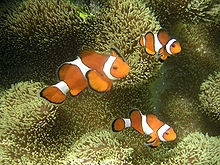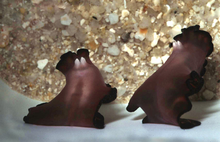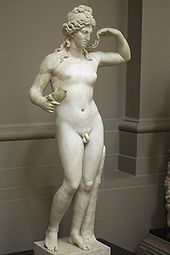Hermaphrodite

A hermaphrodite (/hərˈmæfrəˌdaɪt/) is a sexually reproducing organism that produces both male and female gametes.[1] Animal species in which individuals are of different sexes, either male or female but not both, are gonochoric, which is the opposite of hermaphroditic.[2]
The individuals of many
A rough estimate of the number of hermaphroditic animal species is 65,000, about 5% of all animal species, or 33% excluding insects. Insects are almost exclusively gonochoric, and no definitive cases of hermaphroditism have been demonstrated in this group.[4] There are no known hermaphroditic species among mammals[5] or birds.[6]
About 94% of
Hermaphrodism is not to be confused with intersexuality, which is a separate and unrelated phenomenon. While intersex people are commonly referred to as hermaphrodites in medical literature, this usage is now considered to be stigmatizing and misleading,[7][8] as intersex people do not have functional sets of both male and female organs.[9][10] People previously incorrectly categorized as "true" hermaphrodites are now called with having Ovotesticular Syndrome.
Etymology
The term hermaphrodite derives from the
Animals
Sequential hermaphrodites



Sequential hermaphrodites (
Sequential hermaphrodites can be divided into three broad categories:
- Protandry: Where an organism develops as a male, and then changes sex to a female.[15]
- Example: The clownfish (genus Amphiprion) are colorful reef fish found living in symbiosis with sea anemones. Generally one anemone contains a 'harem', consisting of a large female, a smaller reproductive male, and even smaller non-reproductive males. If the female is removed, the reproductive male will change sex and the largest of the non-reproductive males will mature and become reproductive. It has been shown that fishing pressure can change when the switch from male to female occurs, since fishermen usually prefer to catch the larger fish. The populations are generally changing sex at a smaller size, due to natural selection.
- Protogyny: Where the organism develops as a female, and then changes sex to a male.[15]
- Example: Labridae) are a group of reef fish in which protogyny is common. Wrasses also have an uncommon life history strategy, which is termed diandry (literally, two males). In these species, two male morphs exists: an initial phase male and a terminal phase male. Initial phase males do not look like males and spawn in groups with females. They are not territorial. They are, perhaps, female mimics (which is why they are found swimming in group with females). Terminal phase males are territorial and have a distinctively bright coloration.[19]Individuals are born as males or females, but if they are born males, they are not born as terminal phase males. Females and initial phase males can become terminal phase males. Usually, the most dominant female or initial phase male replaces any terminal phase male when those males die or abandon the group.
- Example:
- Bidirectional sex changers: Where an organism has female and male reproductive organs, but may act either as a female or as a male during different stages in life.[15]
- Example: Lythrypnus dalli (Family Lythrypnus) are a group of coral reef fish in which bidirectional sex change occurs. Once a social hierarchy is established a fish changes sex according to its social status, regardless of the initial sex, based on a simple principle: if the fish expresses subordinate behavior then it changes its sex to female, and if the fish expresses dominant or non-dominant superior behavior then it changes its sex to male.[20]
Dichogamy can have both conservation-related implications for humans, as mentioned above, as well as economic implications. For instance,
Simultaneous hermaphrodites


- Pulmonate land snails and land slugs are perhaps the best-known kinds of simultaneous hermaphrodites, and are the most widespread of terrestrial animals possessing this sexual polymorphism. Sexual material is exchanged between both animals via spermatophores, and is then stored in the spermatheca. After exchange of spermatozoa, both animals will lay fertilized eggs after a period of gestation. The eggs will proceed to hatch after a development period. Snails typically reproduce from early spring through late autumn.[21]
- Banana slugs are an example of a hermaphroditic gastropod. Mating with a partner is more desirable biologically than self-fertilization, as the genetic material of the resultant offspring is varied, but if mating with a partner is not possible, self-fertilization is practiced. The male sexual organ of an adult banana slug is quite large in proportion to its size, as well as compared to the female organ. It is possible for banana slugs, while mating, to become stuck together. If a substantial amount of wiggling fails to separate them, the male organ will be bitten off (using the slug's radula), see apophallation. If a banana slug has lost its male sexual organ, it can still mate as a female, making hermaphroditism a valuable adaptation.[22]
- The species of colourful sea slugs Goniobranchus reticulatus is hermaphroditic, with both male and female organs active at the same time during copulation. After mating, the external portion of the penis detaches, but is able to regrow within 24 hours.[23][24]
- Earthworms are another example of a simultaneous hermaphrodite. Although they possess ovaries and testes, they have a protective mechanism against self-fertilization. Sexual reproduction occurs when two worms meet and exchange gametes, copulating on damp nights during warm seasons.
- The free-living hermaphroditic nematode Caenorhabditis elegans reproduces primarily by self-fertilization, but infrequent out-crossing events occur at a rate of approximately 1%.[25]
- Hamlets do not practice self-fertilization, but a pair will mate multiple times over several nights, taking turns between which one acts as the male and which acts as the female.[26][failed verification]
- The mangrove killifish (Kryptolebias marmoratus) are simultaneous hermaphrodites, producing both eggs and sperm and routinely reproducing by self-fertilization. Each individual normally fertilizes itself when an egg and sperm produced by an internal organ unite inside the fish's body.[27] This species is also regarded as the only known vertebrate species that can reproduce by self fertilization.[28]
Pseudohermaphroditism
When spotted hyenas were first scientifically observed by explorers, they were thought to be hermaphrodites. Early observations of spotted hyenas in the wild led researchers to believe that all spotted hyenas, male and female, were born with what appeared to be a penis. The apparent penis in female spotted hyenas is in fact an enlarged clitoris, which contains an external birth canal.[29][30] It can be difficult to determine the sex of wild spotted hyenas until sexual maturity, when they may become pregnant. When a female spotted hyena gives birth, they pass the cub through the cervix internally, but then pass it out through the elongated clitoris.[31]
Plants
The term hermaphrodite is used in
Monoecy
Flowering plant species with separate, imperfect, male and female flowers on the same individual are called
Andromonecy
In andromonecious species, the plants produce perfect (hermaphrodite) flowers and separate fertile male flowers that are sterile as female.[36][37] Andromonecy occurs in about 4000 species of flowering plants (2% of flowering plants).[38]
Gynomonoecy
In gynomonoecious species, the plants produce hermaphrodite flowers and separate male-sterile pistillate flowers.[36] One example is the meadow saxifrage, Saxifraga granulata.[39] Charles Darwin gave several other examples in his 1877 book "The Different Forms of Flowers on Plants of the Same Species".[40]
About 57% of moss species and 68% of liverworts are unisexual, meaning that their gametophytes produce either male or female gametes, but not both.[41]: 377
Sequential hermaphroditism is common in bryophytes and some vascular plants.[citation needed]
Use regarding humans
| Intersex topics |
|---|
 |


Historically, the term hermaphrodite was used in law to refer to people whose sex was in doubt. The 12th-century Decretum Gratiani states that "Whether an hermaphrodite may witness a testament, depends on which sex prevails" ("Hermafroditus an ad testamentum adhiberi possit, qualitas sexus incalescentis ostendit.").[44][45].
During the
The term intersex describes a wide variety of combinations of what are considered male and female biological characteristics. Intersex biology may include, for example, ambiguous-looking external genitalia, karyotypes that include mixed XX and XY chromosome pairs (46XX/46XY, 46XX/47XXY or 45X/XY mosaic). Clinically, medicine currently describes intersex people as having disorders of sex development,[52] a term that has been vigorously challenged.[53] This is particularly significant because of the relationship between medical terminology and medical intervention.[54]
In some cases, intersex traits are caused by unusual levels of sex hormones, which may be the result of an atypical set of sex chromosomes.[
Fetuses before sexual differentiation are sometimes described as female by doctors explaining the process.[58][page needed] This is not technically true. Before this stage, humans are simply undifferentiated and possess a paramesonephric duct, a mesonephric duct, and a genital tubercle.[citation needed]
Evolution
The evolution of anisogamy may have contributed to the evolution of simultaneous hermaphroditism and sequential hermaphroditism,[6] but it remains unclear if the evolution of anisogamy first led to hermaphroditism or gonochorism.[59]: 213 It is possible that hermaphroditism evolved from gonochorism, or vice versa. Most studies on its evolution focus on plants, and its evolution in animals is unclear as of December 2017[update].[60]
Simultaneous hermaphroditism that exclusively reproduces through self-fertilization has evolved many times in plants and animals, but it might not last long evolutionarily.[61]: 14
In animals
Hermaphroditism is
In plants
It is widely accepted that the first vascular plants were outcrossing hermaphrodites.[64] In flowering plants, hermaphroditism is ancestral to dioecy.[65]
Hermaphroditism in plants may promote self fertilization in pioneer populations.[66] However, plants have evolved multiple different mechanisms to avoid self-fertilization in hermaphrodites, including sequential hermaphroditism, molecular recognition systems and mechanical or morphological mechanisms such as heterostyly.[67]: 73, 74
See also
- Asexual reproduction
- Trioecy
- Androgyny
- Futanari
- Gonochorism
- Gynandromorph
- Self-pollination
- Self-fertilization
References
- ^ ISBN 978-0-231-52715-6.
- S2CID 240938739.
- S2CID 23849389.
- ISBN 978-3-642-66071-9.
- ISBN 978-3-642-85001-1.
- ^ PMID 28032683.
Of note, the otherwise well-studied insects, birds, and mammals are strikingly absent here—with not a single species among these groups showing hermaphroditism (for details on a supposedly hermaphroditic scale insect, however, see Gardner and Ross, 2011).
- ^ Herndon A. "Getting Rid of "Hermaphroditism" Once and For All". Intersex Society of North America. Archived from the original on 27 September 2011. Retrieved 2 October 2011.
- ^ a b "Is a person who is intersex a hermaphrodite?". Intersex Society of North America. Retrieved 2024-01-20.
The mythological term "hermaphrodite" implies that a person is both fully male and fully female. This is a physiologic impossibility. The words "hermaphrodite" and "pseudo-hermaphrodite" are stigmatizing and misleading words.
- ISBN 978-3-319-47829-6
- ^ ISBN 978-1-4875-9337-7.
In the past, the term hermaphrodite was widely applied in such cases, but humans are not hermaphroditic. In a truly hermaphroditic species, individuals have functional sets of male and female organs.
- ^ "Definition of hermaphroditus". Numen: The Latin Lexicon. Archived from the original on 6 November 2014. Retrieved 19 July 2013.
- ^ Ovid, Metamorphoses, Book IV: The story of Hermaphroditus and Salmacis.
- ^ "LacusCurtius • Diodorus Siculus — Book IV Chapters 1‑7". penelope.uchicago.edu.
- ^ "Online Etymology Dictionary". Archived from the original on 5 November 2013. Retrieved 3 June 2012.
- ^ OCLC 299866547.
- ISBN 9781439879191. Archivedfrom the original on 7 November 2017 – via Google Books.
- PMID 21227182.
- S2CID 38139187.
- ISBN 978-0312253776.
- .
- PMID 26306176.
- S2CID 83829239.
- ^ Morelle R (12 February 2013). "Sea slug's 'disposable penis' surprises". BBC News.
- PMID 23407499.
- S2CID 2229622.
- ISBN 978-1-305-85610-3.
- S2CID 9474211.
- S2CID 13639701.
- ^ "The Painful Realities of Hyena Sex". Live Science. 26 April 2006. Archived from the original on 2012-11-19.
- ^ "Hyena Graphic". EurekAlert!. Archived from the original on 2011-03-10. Retrieved 2011-03-20.
- ^ "Hermaphrodite Hyenas?". Archived from the original on 2010-11-23. Retrieved 2011-03-19.
- ISBN 978-0-07-068177-4.
- ^ Molnar S (17 February 2004). "Plant Reproductive Systems". Evolution and the Origins of Life. Geocities.com. Archived from the original on 2009-10-22. Retrieved 12 September 2009.
- ISBN 978-0-19-966159-6.
- S2CID 90740232.
- ^ ISBN 978-1-108-49985-9. Archivedfrom the original on 1 April 2021. Retrieved 29 March 2021.
- PMID 19671577.
- S2CID 781464.
- S2CID 21632274.
- ^ Darwin, Charles (1877). The different forms of flowers on plants of the same species. London: John Murray.
- )
- ^ "LAKAPATI: The "Transgender" Tagalog Deity? Not so fast…". THE ASWANG PROJECT. 29 November 2018. Retrieved 2019-07-03.
- ^ Schultheiss, Herrmann & Jonas 2006, p. 358.
- ^ Decretum Gratiani, C. 4, q. 2 et 3, c. 3
- ^ "Decretum Gratiani (Kirchenrechtssammlung)". Bayerische StaatsBibliothek (Bavarian State Library). February 5, 2009. Archived from the original on December 20, 2016.
- ^ chevalier de Jaucourt, Louis (1765). "Hermaphrodite". Encyclopedia of Diderot & d'Alembert. 8: 165–167. Retrieved 13 April 2023.
- ^ E Coke, The First Part of the Institutes of the Laws of England, Institutes 8.a. (1st Am. Ed. 1812).
- SSRN 896307.
- ISBN 978-0-8018-9155-7.
- S2CID 39459050. Archived from the original(PDF) on 20 December 2016. Retrieved 27 July 2016.
- PMID 17304046.
use of the words "hermaphrodite," "pseudohermaphrodite," and "intersex" should be abandoned, as they either are confusing or have a negative social connotation that may be perceived as harmful by some patients and parents.
- ISBN 978-0-85724-575-5.
- .
- Organisation Intersex International Australia, Black E, Bond K, Briffa T, Carpenter M, Morgan, Cody C, David A, Driver B, Hannaford C, Harlow E, Hart B, Hart P, Leckey D, Lum S, Mitchell MB, Nyhuis E, O'Callaghan B, Perrin S, Smith C, Williams T, Yang I, Yovanovic (March 2017), Darlington Statement, archived from the originalon 2017-03-22, retrieved March 21, 2017
- )
- ^ Council of Europe; Commissioner for Human Rights (April 2015), Human rights and intersex people, Issue Paper, archived from the original on 2016-01-06, retrieved 2018-06-10
- PMID 10602113.
- OCLC 57722472.
- ISBN 978-0-12-800426-5. Archived from the original on 2021-05-06. Retrieved 2021-09-29.)
{{cite book}}: CS1 maint: bot: original URL status unknown (link - ^ PMID 29207942.
- ISBN 978-3-319-94139-4.
- PMID 23817661.
- ISBN 978-0-12-401729-0.
- ISBN 978-0-12-815570-7.
- ISBN 978-3-030-46012-9.
- ISBN 978-1-108-42201-7.
- ISBN 0-87893-403-0.
Further reading
- "Bony Fishes: Reproduction". SeaWorld/Busch Gardens Animal Infobooks. Busch Entertainment Corporation. 2009. Archived from the original on 25 July 2011. Retrieved 12 September 2009.
- Discovery Health Channel, (2007) "I Am My Own Twin"
- Kim KR, Kwon Y, Joung JY, Kim KS, Ayala AG, Ro JY (October 2002). "True hermaphroditism and mixed gonadal dysgenesis in young children: a clinicopathologic study of 10 cases". Modern Pathology. 15 (10): 1013–9. PMID 12379746.
- Randall JE (2005). Reef and Shore Fishes of the South Pacific: New Caledonia to Tahiti and the Pitcairn Islands. Honolulu, Hawaii: University of Hawaii Press. pp. 346, 387. OCLC 52152732.
- Chase C (1998). "Affronting Reason". In Atkins D (ed.). Looking Queer: Body Image and Identity in Lesbian, Bisexual, Gay, and Transgender Communities. New York: Haworth Press. pp. 205–219. OCLC 38519315.
- OCLC 141382073.
- OCLC 35364729.
- Schultheiss D, Herrmann TR, Jonas U (March 2006). "Early photo-illustration of a hermaphrodite by the French photographer and artist Nadar in 1860". The Journal of Sexual Medicine. 3 (2): 355–60. PMID 16490032. (subscription required)
